Learning to play an instrument like the banjo is a rewarding endeavor that brings joy and creativity to one’s life.
It’s crucial, however, to understand the learning process and what it entails. This guide provides a comprehensive understanding of how long does it take to learn banjo.
Several factors influence the process of mastering the banjo. These can include:
- Your background in music
- The amount of time you have to practice daily
- The complexity of the songs you wish to play
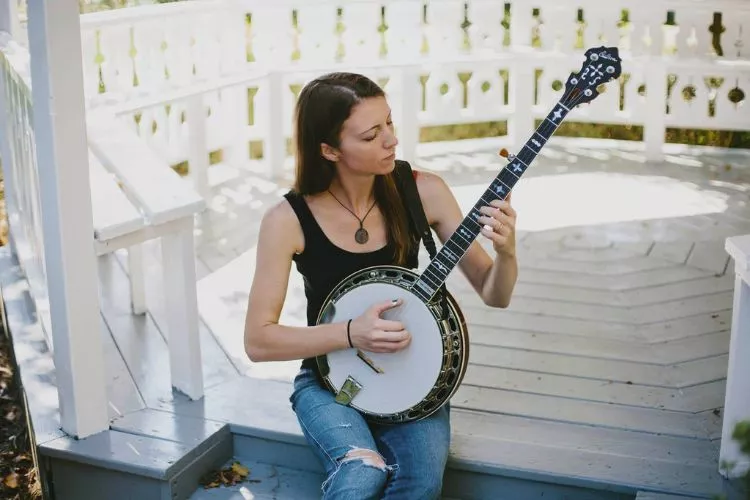
Although it’s natural to want an exact timetable, learning the banjo isn’t a race but a journey. It’s important to set proper expectations for progress.
Progress can vary based on factors like the difficulty level of the tasks you’re attempting, persistence, and even the quality of your practice.
Remember that patience and regular practice are key to mastering this instrument.
In this comprehensive guide, I will delve into more detail about these factors and provide a roadmap to understanding how long it might take to learn the banjo.
Contents
🎶How long does it take to learn banjo?
Learning the banjo can vary greatly from person to person, but it takes about 6 months to a year to gain basic proficiency.
Within this time, you can expect to learn simple songs and techniques, understand basic music theory, and develop your playing style.
This estimate assumes you practice for about 20-30 minutes at least 5 days a week.
However, reaching an advanced level can take several years of consistent practice and dedication. It’s important to remember that everyone progresses at their own pace.
Factors like previous musical experience, learning style, and quality of instruction play a significant role in determining how long does it take to learn banjo.
Patience, regular practice, and a passion for the instrument will ultimately contribute to a successful learning experience.
🎶Factors That Affect Learning Time
With numerous elements, learning to play the banjo isn’t a one-size-fits-all journey. Here are some key individual factors that can significantly influence learning time:
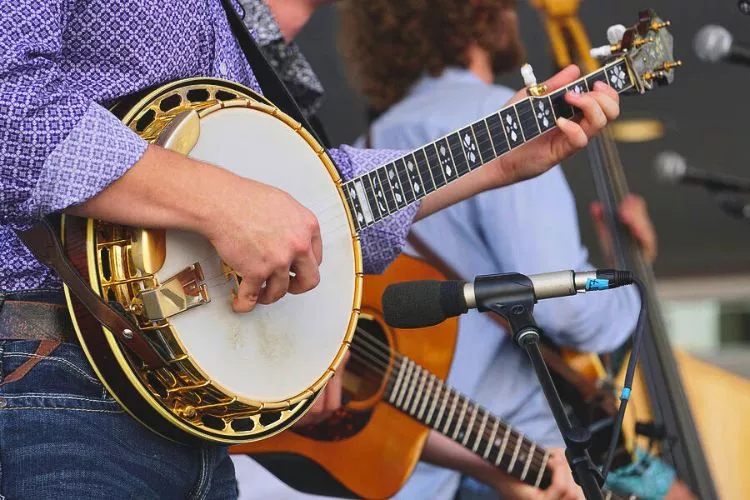
Musical Background and Experience
How versed you are in music can greatly influence how fast you grasp learning the banjo. This includes prior understanding and knowledge of musical concepts, principles, and experiences.
- Prior Experience with Stringed Instruments: Having experience with stringed instruments like the guitar or violin can confer an advantage when learning the banjo, as you’ll already be familiar with fingering techniques.
- Ability to Read Sheet Music and Tabs: If you can read sheet music and tabs, you’ll likely learn faster. This skill can significantly reduce the time required to learn new songs.
- Ear Training and Understanding of Rhythm: Possessing a good sense of rhythm and discerning different tones can help speed the learning process. These skills enhance your ability to play naturally and with the proper timing and phrasing.
Time Commitment
The amount of time you can dedicate to learning the banjo will directly influence your speed at mastering the instrument. Frequency, duration, and practice quality are pivotal in achieving proficiency.
Balancing with Other Life Activities: Your ability to balance learning the banjo with other aspects of your life, such as work, studying, or family obligations, could impact your progression rate.
Those with busy schedules may find it slower to adapt to the instrument.
Learning Style
Your learning style can significantly influence how fast you pick up the banjo. Different individuals have unique ways of learning, which can be optimized to facilitate quicker mastering of the banjo.
- Self-taught vs. Formal Lessons: While self-taught offers flexibility and autonomy, formal lessons provide structured learning, access to a mentor, and immediate feedback — all of which could accelerate your learning process.
- Online vs. In-person Instruction: Both online and in-person instruction have merits. While online lessons provide flexibility and a wide array of learning resources, in-person instruction offers more personalized feedback and guidance. Your choice between the two could dictate your pace of learning.
Type of Banjo
The type of banjo plays a significant role in learning time. A 4-string banjo, either a tenor or plectrum, is relatively simpler due to fewer strings, thus less time-consuming for a beginner.
A 5-string banjo, typically used in bluegrass and folk music, displays a broader tonal range but requires more complex fingerpicking techniques, causing increased learning time.
The 6-string banjo combines guitar fingering techniques with banjo sound, making it a complicated but versatile choice and extending the learning timeline further.
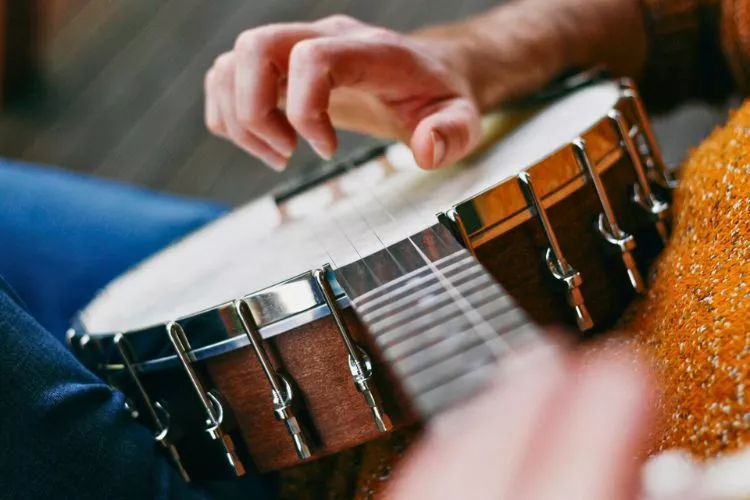
In summary, lesser strings generally mean shorter learning time, though tonal complexity and versatility increase with more strings.
4-string (tenor, plectrum)
Tenor and plectrum banjos have 4 strings and are commonly used in various musical styles, such as traditional jazz, Celtic, and Dixieland music.
These banjos may be easier for beginners due to their shorter necks and fewer strings.
- Tenor banjos are often favored in Irish music, and the shorter scale length makes them suitable for playing with a pick, allowing for faster tempo playing.
- Plectrum banjos are played with a plectrum and are more popular in Dixieland and early jazz styles.
5-string
The 5-string banjo is the most popular type among bluegrass and clawhammer styles. With an additional fifth string to learn, the learning curve might be steeper for a beginner, but this configuration provides a fuller sound and richer musical possibilities.
6-string
A 6-string banjo, also referred to as a banjitar or guitjo, is a unique hybrid that combines the banjo’s body and the guitar’s neck. This type might be easier for guitar players transitioning to a banjo since they’re already familiar with guitar tuning and fingerings.
Tuning and Musical Styles
Different banjo styles are associated with specific tunings and techniques, which can determine how quickly someone can learn to play the instrument proficiently.

- Clawhammer: Clawhammer, a traditional playing style primarily used for the 5-string banjo, emphasizes a more rhythmic approach. To master this style, you must practice prominent hammer-on and pull-off techniques, creating a percussive, “bouncy” sound.
- Bluegrass: Bluegrass, another popular playing style, focuses on the 5-string banjo and requires you to learn intricate picking techniques. Players often use fingerpicks for increased projection and speed. Mastering the bluegrass style will take time due to its complex picking patterns and finger independence requirements.
- Irish and Celtic: Irish and Celtic styles require proficiency in traditional jigs, reels, and other dance-oriented rhythms. These styles are more common on 4-string tenor banjos and involve learning unique ornamentation techniques such as rolls, slides, and cuts.
- Jazz: Jazz styles on the banjo are usually found in 4-string plectrum and tenor banjos, focusing on chordal accompaniment and more intricate melodic lines. Learning jazz on the banjo can be challenging, as it demands good finger skills and a solid understanding of music theory.
Short-term vs. Long-term Goals: Impact on Banjo Learning Time
Short-term goals often involve:
- Mastering basic skills such as understanding note reading.
- Learning simple chords and songs.
- Perfecting basic strumming or picking techniques.
These goals are usually achievable in a fairly brief period, leading to a sense of accomplishment and motivation for beginners, which can shorten the learning time.
On the other hand, long-term goals might include complete mastery of the instrument, proficiency in complex songs, creation of original compositions, or versatile command over various banjo types.
These require extended dedication, time, and practice. Although long-term goals raise the learning timeline substantially, they also lead to comprehensive mastery of the banjo.
In conclusion, the specificity and extent of your goals will directly influence your banjo learning timeline.
🎶Stages of Banjo Learning
Learning the banjo encompasses distinct stages, starting with mastering the basics, which includes tuning, essential chords, scales, and simple songs over 1-3 months.
The intermediate stage focuses on improving specific picking styles and rhythm patterns, and learning more complex songs, typically within 3-9 months.

The advanced stage involves mastering intricate techniques, complex songs, and possibly composition and improvisation during the 9-24 months.
The proficiency level is then capped off with continuous practice to maintain and enhance skills acquired. The duration of each stage may vary based on individual pace and dedication.
Stage 1: The Basics
Time frame: 1-3 months
During Stage 1 of banjo learning, the goal is to have a solid foundation by acquiring essential skills and knowledge. This includes:
Tuning the banjo: Familiarize yourself with the tuning pegs and learn how to tune your banjo accurately to achieve the desired sound.
- Essential chords and scales: Understand basic chord structures and scales, which are crucial to playing various songs.
- Basic banjo rolls and picking patterns: Develop fundamental banjo-specific techniques like rolls and picking patterns to start building your platform for more complex play.
- Basic strumming techniques: Master essential techniques to create rhythmic patterns and achieve a crisp sound.
- Learning simple songs: Apply the above skills by learning beginner-friendly songs, increasing your comfort and confidence with the instrument.
By the end of Stage 1, you will have a good grasp of basic banjo techniques, setting the stage for more advanced learning.
Stage 2: Developing Technique
- Expanding chord vocabulary: This involves learning minor, seventh, and ninth chords, along with complex chord transitions. Studying these new chords helps you enrich your tonal range, adding depth and variety to your performances.
- Fingerpicking techniques: Focusing on each finger’s role, you’ll become adept at single strokes (strumming one string at a time), alternating strokes (alternating between strings during strumming), and double-thumb techniques (using the thumb for hitting non-sequential strings). These techniques offer rhythmic diversity and tonal richness.
- Slides, hammer-ons, and pull-offs: These advanced techniques let you change pitch mid-note. Slides smoothly transition from one fret to another, hammer-ons involve striking a string without plucking, and pull-offs are the reverse. These contribute to expressive, dynamic music.
- Improvising chord changes: You’ll practice changing chords in a fluid and creative way without disrupting rhythm or melody. This essential ability allows flexibility during jamming sessions or when adapting a song.
- Building a repertoire of songs: At this stage, you’ll accumulate a bank of increasingly complex songs from different genres. This challenges and polishes your skills while creating a catalog to showcase your capabilities.
Stage 3: Intermediate Skills
Time frame: 6-12 months
In Stage 3, you’ll refine your skills further while navigating toward more advanced techniques and knowledge:
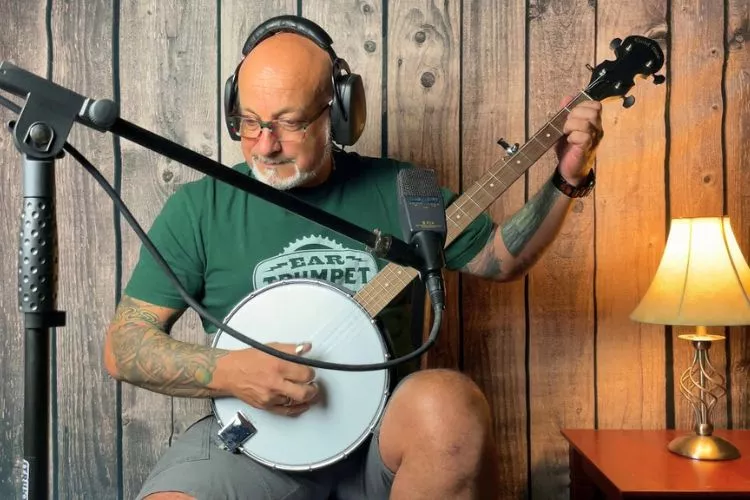
- Mastering various tunings: You’ll learn variations beyond the standard, such as double-C, sawmill, or open-G, aligning your tuning to specific songs or genres.
- Exploring different genres and playing styles: Whether it’s traditional bluegrass, clawhammer, or folk-style playing, this stage involves broadening your musical horizons across genres and styles.
- Developing speed and agility centers around building speed without losing precision, promoting clean and quick finger movements.
- Advanced picking techniques: Techniques like melodic picking or Scruggs style enhance your play, allowing greater freedom of expression.
- Soloing and improvisation: This entails constructing banjo solos or improvising during live performances, which is essential for personal style development and advancing your musical dynamics.
- Understanding music theory as it applies to the banjo: Here, you’ll learn scales, chord progressions, and key signatures as they apply to the banjo, laying a foundation for advanced comprehension and application.
By the end of Stage 3, you’ll have a detailed understanding of the banjo, its playing techniques, and its applicability across different music genres and styles.
Stage 4: Advanced Skills
Time frame: 1-2 years
During the final learning stage, you start displaying advanced proficiency, even mastery, over the instrument:
- Developing a personal style: At this point, your techniques, genre preferences, and expressiveness form your unique banjo-playing style.
- Mastering complex, challenging material: Here, you tackle intricate music pieces with multiple layers of rhythmic complexity, tonal variations, and technical demands.
- Composing your songs and solos: Understanding and proficiency lead to creativity. You’ll start composing your original work, whether full songs or unique solos, to showcase your musicality.
- Performing in various settings: From intimate home settings to concert stages, you’ll gain competence and confidence performing in various situations, building your adaptability and stage presence.
- Teaching and mentoring others: With your knowledge and experience, you’ll be equipped to mentor beginners or fellow learners, reinforcing your understanding and passing it down to another generation of players.
Upon concluding Stage 4, you’ll have transformed from a novice banjo player into a proficient, skilled musician capable of creating, performing, and teaching.
🎶Additional Resources and Tips for Success
Just as important as the technical stages of learning the banjo, here are a few resources and tips that can greatly contribute to your success:
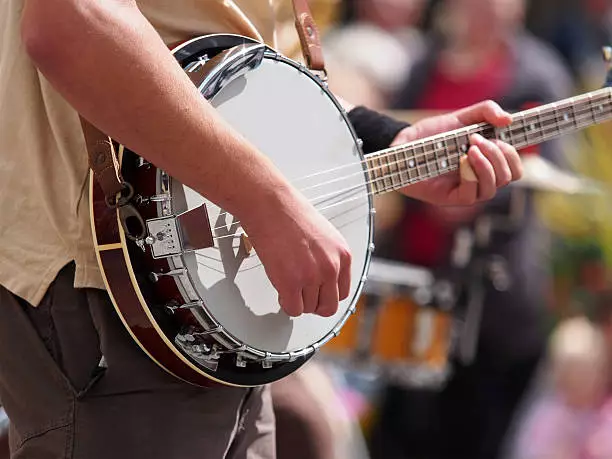
- Online resources for learning and community: Leveraging online banjo lessons, tutorials, or forums can provide valuable lessons and much-needed support. Websites like Banjo Hangout or YouTube channels dedicated to banjo lessons are excellent places to start.
- Books and instructional materials: Books like “Earl Scruggs and the 5-String Banjo” or “The How and the Tao of Old-Time Banjo” offer a wealth of information. These instructional DVDs or software are indispensable resources for self-taught students.
- Setting up a practice routine: Consistent practice is key for mastery. Set a daily or weekly routine, ensuring dedicated time for techniques, songs, and improvisation.
- Perseverance and overcoming plateaus: Learning always comes with hurdles. Persistence is crucial when progress seems slow. Keep practicing, possibly focusing on another technique or song, and you’ll soon overcome the plateau.
- Why enjoying the journey is crucial: Banjo playing should be fun! Enjoy the process of learning new songs or techniques, cherish small wins, and remember: It’s the journey, not just the destination, that makes a musician.
By employing both the practical learning stages and these tips, you’ll be set on a successful path of banjo mastery.
🎶Frequently Asked Questions (FAQs)
Difficulty in learning to play the banjo can vary from person to person based on their musical background and commitment. However, it’s generally considered easy to pick up the basics with regular practice.
Practicing the banjo for at least 1 hour daily can help you progress. However, the quality of practice is more important than the quantity.
Both instruments have their challenges. The main difference lies in the playing technique. While some might find the guitar easier to start, others may find the banjo’s focus on the picking hand technique easier to grasp.
Yes, with ample online resources like tutorials and guides, one can certainly self-teach themselves to play the banjo.
No age is too old to learn anything new, including the banjo. So, 30 is certainly not too old to start learning to play the banjo.
Like the above answer, age doesn’t limit one’s ability to learn something new. So, 60 is not too old to start learning to play the banjo.
Overcoming Common Challenges While Learning the Banjo
While learning to play the banjo can be an enjoyable and rewarding journey, it’s not without its challenges. Understanding these common obstacles will help you prepare and remain motivated throughout your learning process.
1. Dealing with Finger Fatigue and Pain
Many beginners struggle with finger fatigue, especially when trying to master complex picking patterns or chord transitions. This is a natural part of the process as your fingers get used to the demands of the instrument. To prevent injury and discomfort, practice regularly but take short breaks to avoid overworking your hands. You can also try finger exercises to build strength and dexterity.
2. Staying Motivated
The banjo requires patience, and progress can sometimes feel slow, especially when you’re working on difficult techniques. Setting small, achievable goals can help maintain motivation. Whether it’s learning a new song or mastering a specific technique, celebrating small victories can keep you engaged. Additionally, don’t be afraid to explore different genres and styles of music to keep things fresh and exciting.
3. Understanding Timing and Rhythm
Timing and rhythm are crucial when playing any instrument, and the banjo is no exception. Bluegrass, folk, and clawhammer styles often require fast, intricate timing. If rhythm is a challenge, try practicing with a metronome or along with backing tracks to improve your timing and ability to stay in sync with a band. You can also record yourself playing and listen back to identify areas where your rhythm may need improvement.
4. Avoiding Plateaus
As you progress, you may encounter plateaus where it feels like you’re not improving despite putting in the effort. This is a normal part of the learning process, but it can be frustrating. To break through these plateaus, try focusing on one specific technique or song. You can also seek feedback from a teacher or fellow player to get new perspectives on areas to improve.
By anticipating these challenges and finding strategies to overcome them, you’ll set yourself up for continued success in learning the banjo.
Conclusion:
The time it takes to learn the banjo largely depends on the individual’s commitment, previous musical knowledge, and practice habits.
It is generally considered that after a consistent practice of 1 hour daily, basic skills can be grasped within a few months.
Age doesn’t limit one’s capacity to learn the banjo; dedication and focused practice play a pivotal role.
Remember, the journey of learning an instrument like the banjo isn’t just about the destination; it’s about enjoying the process too.
